The Best Traditional Vietnamese Food (To Eat During The Holidays)
Traditional Vietnamese Food // Our Favourite Dishes
Cuisine is passed down from generation to generation and defines a country’s culture, with its history, values, and beliefs. Traditional Vietnamese food is no different, with each also revealing a delightful cultural story behind them.
Food is a common thread that connects us, no matter what culture we come from
A quote from Poh Ling Yeow
In this blog, we will not only discuss traditional Vietnamese food, but look through the lens of the Vietnamese holidays in which foods strongly represent Vietnamese cultural significance.
We break the year down into 3 of Vietnam’s biggest holidays and introduce you to the best Vietnamese food we eat during these times.
I hope you aren’t hungry…!
Lunar New Year // Tết Nguyên Đán
Traditional Vietnamese Food #1 | Bánh Chưng & Bánh Tét
Traditional Vietnamese Food #2 | Nem Rán, Chả Ram & Chả Giò
Traditional Vietnamese Food #3 | Dưa Hành & Củ Kiệu
Traditional Vietnamese Food #4 | Thịt Kho Hột Vịt & Thịt đông
Traditional Vietnamese Food #5 | Canh Khổ Qua
Hung Kings’ Commemoration Day // Giỗ tổ Hùng Vương
Traditional Vietnamese Food #1 | Bánh Chưng & Bánh Dày
Traditional Vietnamese Food #2 | Xôi Gấc
Traditional Vietnamese Food #3 | Gà Luộc
Traditional Vietnamese Food #4 | Cơm Tẻ Hạt Sen
Mid-Year Festival // Tết đoan Ngọ
Traditional Vietnamese Food #1 | Rượu Nếp Cẩm
Traditional Vietnamese Food #2 | Bánh ú Lá Tro
Traditional Vietnamese Food #3 | Thịt Vịt
Traditional Vietnamese Food | FAQs
Before we get started with the best traditional Vietnamese food we also wrote an article about the top Vietnamese street foods we think you’ll also love as well…
You don’t want to miss these.
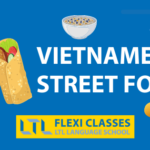
6 Must-Try Vietnamese Street Food & Snacks // North vs South
Vietnamese Street Food has a lot of surprises we think you’ve never seen before! Today we introduce you 3 from the north and 3 from the south of Vietnam.
Lunar New Year // Tết Nguyên Đán
Tết is celebrated in many Asian countries.
Vietnamese New Year is all about change, progress, a better upcoming year, and experiencing the joy of family reunion.
It is also a holiday for people to rest after a year of hard-work.
Traditional Vietnamese cuisine during Tết can vary between regions, however, there are some common things also.
It’s those we take a look at now!
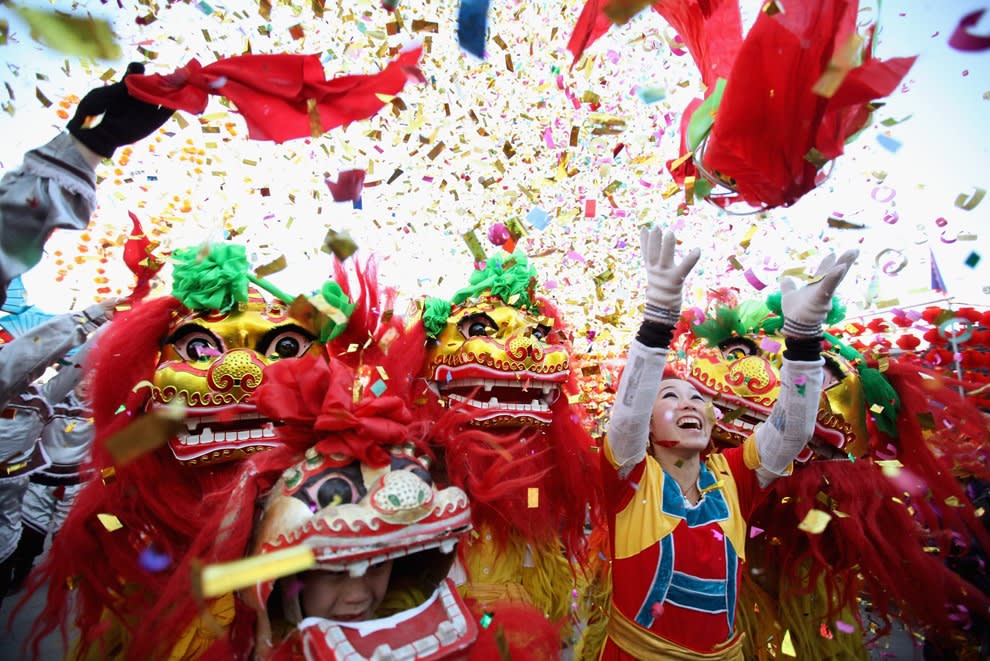
Traditional Vietnamese Food #1 | Bánh Chưng & Bánh Tét
We can’t have a blog about traditional Vietnamese food and not mention bánh chưng and bánh tét also known as a sticky rice cake.
Bánh chưng is commonly served in the North, while bánh tét is a traditional recipe in the Central and Southern regions.
Bánh chưng is a square rice cake made with sticky rice with green beans and pork covered with premium leaves.
The Bánh chưng legend is well-known for the story behind it.
- Bánh chưng symbolizes the ground or land expressing gratitude towards the earth.
- It emphasizes the importance of rice and nature in Vietnamese agriculture.
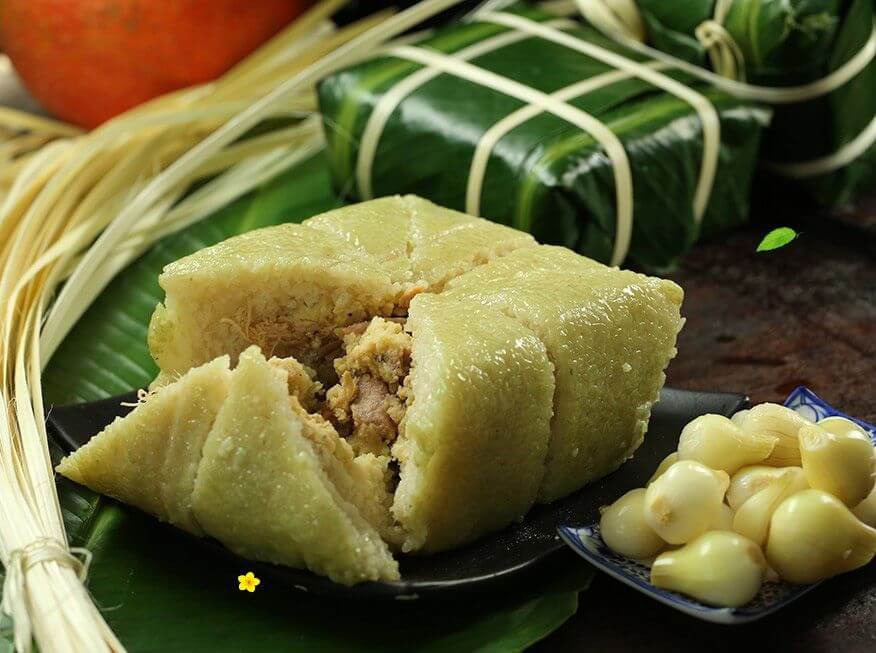
Meanwhile, bánh tét is an amazing sweet or savoury treat for Tết.
- It includes ripened sticky rice, bananas, and black beans wrapped in banana leaves
- Mung bean and pork is also a popular recipe
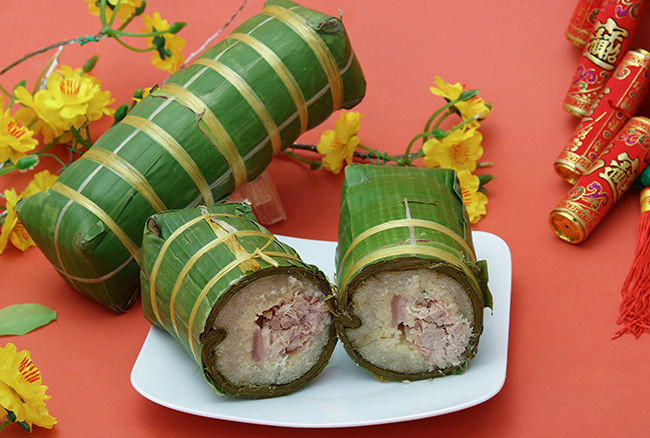
For your reference here are the main ingredients to these two excellent Vietnamese treats with English translation so you can learn them too.
| Savoury bánh tét | Sweet bánh tét |
|---|---|
| Gạo nếp = sticky rice | Gạo nếp = sticky rice |
| Đậu xanh = mung bean | Đậu đen = black bean |
| Thịt heo = pork | Chuối chín = ripe bananas |
| Lá dong = phrynium leaves | Lá chuối = banana leaves |
Traditional Vietnamese Food #2 | Nem Rán, Chả Ram & Chả Giò
In English, the word Spring rolls does not fully justify the different features between nem rán, chả giò and chả ram (Vietnam’s variants of this wonderful treat).
Spring Rolls are of course universally popular though and that gives you an idea of what this delicacy is all about!
Vietnamese and foreign people are crazy about this kind of cuisine. You can easily find it at any Vietnamese restaurant around the world.
Spring rolls are named differently depending on the region of Vietnam.
You would hear nem rán based in Northern Vietnam, chả ram in the Middle, and chả giò in the South.
You can try to make spring roll following recipe below.
Once again, here are the ingredients of this traditional Vietnamese food. You can see how they differ between regions:
| Nem rán (Northern) | Chả ram (Mid Vietnam) | Chả giò (Southern) |
|---|---|---|
| Bánh đa nem = rice paper wrapper | Bánh tráng rế = net spring roll wrapper | Bánh tráng đậu xanh = spring roll wrapper from mung bean |
| Thịt xay = grounded pork | Thịt xay = grounded pork | Thịt xay = grounded pork |
| Củ hành = onions | Củ hành = onions | Củ hành = onions |
| Miến = glass noodles | Trứng gà = eggs | Miến = glass noodles |
| Su hào = kohlrabi | Tôm tươi = fresh shrimps | Mộc nhĩ/nấm mèo = Cat ear mushroom |
| Cà rốt = carrot | Trứng gà = eggs | |
| Mộc nhĩ/nấm mèo = Cat ear mushroom | Cà rốt = carrot | |
| Nấm hương = Shiitake mushrooms | Tôm tươi = fresh shrimps | |
| Trứng gà = eggs | Khoai môn = Indian taro |
More importantly, Vietnamese fried spring rolls generally share a common cooking method and carry the meaning of the unity, love, and reunion of family members.
Traditional Vietnamese Food #3 | Dưa Hành & Củ Kiệu
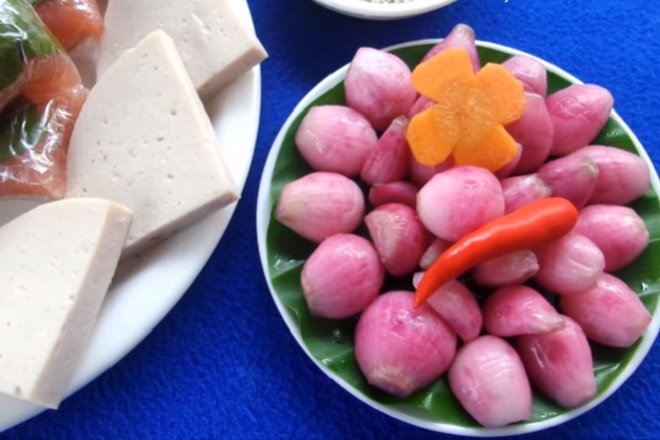
To gain the balance in taste between dishes, Vietnamese people always serve pickles in Tết meals.
They are a low-calorie side dish that allows the stomach to ease and help provide a better appetite during the holiday.
In the North, dưa hành or pickled onion is a popular side dish for celebrating Lunar New Year that is fermented.
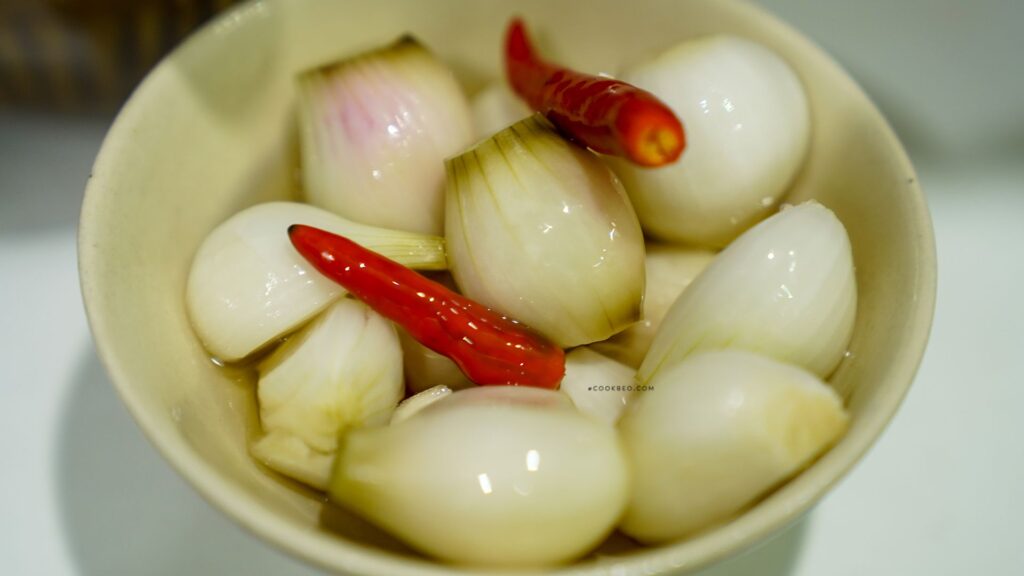
In the Mid and Southern regions of Vietnam, the main ingredient will be củ kiệu muối which means pickled Scallion head.
Củ kiệu (scallion) is a relative of the onion but it has a milder taste.
Unlike dưa hành, củ kiệu can be prepared with various cooking methods as you can see in this video.
Here are some useful translations:
- Dưa hành = pickled onion
- Củ kiệu muối = pickled Scallion head
- Dưa món/Dưa chua = pickles in general
Traditional Vietnamese Food #4 | Thịt Kho Hột Vịt & Thịt đông
A traditional stewed dish that has existed in Vietnam during Tet for thousands of years is thịt kho hột vịt (in the South) or thịt đông (in the North).
The dish is braised pork in coconut juice with eggs.

This traditional stewed meat in the North, however, is totally different from one in the South.
Thịt đông (the northern variant) contains many ingredients such as:
- Mushrooms
- Pork
- Chicken
- Carrot
- Onion
Here is the breakdown of the two variations in northern and southern Vietnam.
| Thịt kho hột vịt (Southern Vietnam) | Thịt đông (Northern Vietnam) |
|---|---|
| Thịt ba chỉ = pork belly meat | Thịt lợn/heo = pork |
| Nước dừa = coconut juice | Tai heo = pig’s ear |
| Trứng vịt = duck eggs | Củ hành = onions |
| Tỏi = garlic | Cà rốt = carrot |
| Ớt = chilies | Mộc nhĩ/nấm mèo = Cat ear mushroom |
| Củ hành = onions | Nấm hương = Shiitake mushrooms |
Take a deeper look at the northern variant of this traditional Vietnamese food in this video below.
Traditional Vietnamese Food #5 | Canh Khổ Qua
During the Tết holiday, Vietnamese people will all try canh khổ qua once.
This is a traditional soup made from bitter melon covered in ground pork and cat ear mushrooms.
“Khổ qua” is a Sino-Vietnamese word describing bitter melon, but it is also a homophone indicating the disappearance of struggles, unfortunate events in life.
- Khổ = bad luck, difficulties
- Qua = disappear, vanish
Hung Kings’ Commemoration Day // Giỗ tổ Hùng Vương
Hung Kings’ Commemoration Day occurs on the tenth day of March in the lunar calendar and is one of the most important traditional holidays in Vietnam.

Vietnamese hold the festival to show their respect and gratitude towards the Hung line of kings who ruled Vietnam.
People are particularly thankful for the contribution and protection of Vietnam from invaders of the nation’s ancient founders.
Let’s have a look at four of the must-have dishes served during the festival.

Vietnamese Public Holidays // A Complete Guide
Besides the Vietnamese Lunar New Year (or Tet Holiday), there are several Vietnamese Public Holidays to celebrate and enjoy throughout the year.
Traditional Vietnamese Food #1 | Bánh Chưng & Bánh Dày
Bánh chưng and bánh dày was the creation of the seventh Hung King-Lang Lieu.
They are both made from sticky rice and are covered with banana leaves or geranium, which implies the protection and love of parents to their children.
- Bánh chưng are filled with pork and mung beans
- Bánh dày has no filling and is made completely from sticky rice
A square shaped bánh chưng symbolises the ground, while the dome-shaped bánh dày represents the sky.
Don’t be surprised if many dishes in Vietnam are made from sticky rice. Sticky rice is an umbrella term that encompasses all Vietnamese dishes with glutinous rice as the base.
Traditional Vietnamese Food #2 | Xôi Gấc
Xôi gấc is…
- Quả gấc = Sweet gourd
- Xôi = Steamed glutinous rice
The colour of Gấc makes the dish a beautiful red.
Its red colour is believed to bring good things and luck to Vietnamese people.
Vietnamese normally eat xôi gấc before carrying out important events in their life.
For example, students usually have xôi gấc before important exams such as the university entrance exam, the final exam, etc.
Traditional Vietnamese Food #3 | Gà Luộc
Next up we go from sweet to meat…
This traditional Vietnamese food appears not only during the Hung Kings’ Commemoration Day but is also popular for special Vietnamese meals: gà luộc.
Gà luộc is simply a whole boiled chicken.
Traditional Vietnamese Food #4 | Cơm Tẻ Hạt Sen
As rice holds a crucial role in Vietnamese culture and life, there must to be two types of rice to gain the balance of yin and yang.
Steamed lotus seed rice – cơm tẻ hạt sen contains two key ingredients…
- Lotus seed
- Rice
The ingredients are mixed, then steamed with a lotus leaf.
Cơm tẻ hạt sen was a luxurious cuisine served only to royal family members. It is a symbol of prosperity and wealth.
So how does this traditional Vietnamese treat look?
Mid-Year Festival // Tết đoan Ngọ
On the 5th day of May in the lunar calendar, the Mid-Year Festival or Tết Đoan Ngọ is celebrated in China, Japan, Korea, and Vietnam.
However, the origin and meaning of this special event in Vietnam is different in other countries.
In fact, the Vietnamese Mid-Year Festival has another name oddly called the Worm-Killing Festival or Tết Diệt Sâu Bọ.
In Vietnam, Tết Đoan Ngọ can be known as a family reunion day when family members enjoy traditional foods together to eliminate “insects” in the body & ward off diseases and disabilities
As foods have defined the specialty of this festival, let’s explore some traditional Vietnamese food that you can find in any family for this special occasion.
Traditional Vietnamese Food #1 | Rượu Nếp Cẩm
The first must-eat food during Tết Đoan Ngọ is rượu nếp/nếp cẩm or black fermented sticky rice.
It can be considered as a dessert.
Rượu nếp cẩm is a black fermented sticky rice, the semi-product in the traditional Vietnamese rice wine-making process.
During the fermentation process, the bacteria soften the rice, making it half sugar, half alcohol in flavour!
Intrigued…? So are we!
The sweet, acidic flavour of the dish is believed to eradicate or remove insects or bad bacteria and diseases in the human body.
- Rượu = wine
- Nếp Cẩm = violet glutinous rice
Traditional Vietnamese Food #2 | Bánh ú Lá Tro
If Northern people normally serve rượu nếp/nếp cẩm, southern people eat bánh ú lá tro.
It’s a treat made from (yep, you guessed it) glutinous rice flour, dipped in lye.
This is a Vietnamese sweet treat in the shape of a pyramid with a mung bean filling inside.
Bánh tro is usually served with sugar syrup or honey and has no filling.
Traditional Vietnamese Food #3 | Thịt Vịt
Thịt vịt or duck meat is an indispensable cuisine in Tết Đoan Ngọ which is most popular in the mid regions of Vietnam.
People use duck meat to cook several dishes in this special event such as vịt quay (roasted duck), vịt luộc (boiled duck) and cháo vịt (duck soup with rice).
People believe that eating duck meat can help you beat the heat in the middle of summer when the temperature is very high.
Moreover, they recognise that in May of the lunar calendar, duck meat has the highest quality as it is more fatty.
- Thịt vịt = duck meat
- Vịt quay = roasted duck
- Vịt luộc = boiled duck
- Cháo vịt = duck soup with rice
In Vietnam everything relates to food.
If we are partaking in a festival, we eat specific foods, as you’ve seen. It’s a big deal for us!
How about your country, comment down below what with traditional food you have during holidays. We’d love to hear from you!
Traditional Vietnamese Food // FAQs
Are Spring Rolls popular in Vietnam?
Yes!
In English, the word Spring rolls can not fully depict the different features between nem rán, chả giò and chả ram (Vietnam’s variants of this wonderful treat).
Spring Rolls are of course universally popular though and that gives you an idea of this delicacy!
Vietnamese and foreign people are crazy about this kind of cuisine. You can easily find it at any Vietnamese restaurant around the world.
Do Vietnamese eat sticky rice?
Sticky rice is really popular in Vietnam, but can vary depending on what region you are in.
Bánh chưng is commonly served in the North, while bánh tét is a traditional recipe in the Central and Southern region.
Bánh chưng is a square rice cake made with sticky rice covering green beans, and pork covered with premium leaves.
Does food in Vietnam vary from north to south?
Yes, greatly.
Normally each major dish has a variant depending on the region.
What is a common food based New Year tradition in Vietnam?
During the Tết holiday (Vietnamese New Year), Vietnamese people will all try canh khổ qua once.
This is a traditional soup made from bitter melon covered in ground pork and cat ear mushroom.
“Khổ qua” is a Sino-Vietnamese word describing bitter melon, but it is also a homophone indicating the disappearance of struggles, unfortunate events in life.
Khổ = bad luck, difficulties
Qua = disappear, vanish
Where to learn Vietnamese for free?
Visit our Vietnamese Grammar Bank for free language lessons 🙂
For studying Vietnamese in Vietnam with professional teachers, make sure to have a look at our programs in Saigon and Hanoi, or contact us to start planning!
Want More From LTL?
FANCY LEARNING VIETNAMESE? We know you’ll love our top-rated online Vietnamese courses. We offer a 7-day free trial to all new online students where you can study 24/7.
What’s more – we even offer Vietnamese courses in Vietnam too. Check out our small group classes for Vietnamese or our individual programs.
Come and be a part of our amazing community!









2 comments
Nothing beats Vietnamese Banh Mi, literally nothing
Oooo you couldn't have said it much better